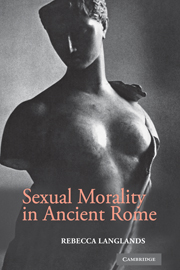Book contents
- Frontmatter
- Contents
- Acknowledgements
- Introduction
- Chapter 1 Sexual virtue on display I: the cults of pudicitia and honours for women
- Chapter 2 Traditional narratives and Livy's Roman history
- Chapter 3 Valerius Maximus: the complexities of past as paradigm
- Chapter 4 Subversive genres: testing the limits of pudicitia
- Chapter 5 Declamation: what part of ‘no’ do you understand?
- Chapter 6 Sexual virtue on display II: oratory and the speeches of Cicero
- Chapter 7 Imperial narratives, imperial interventions
- Conclusion
- Bibliography
- Subject index
- Index locorum
Chapter 5 - Declamation: what part of ‘no’ do you understand?
Published online by Cambridge University Press: 22 September 2009
- Frontmatter
- Contents
- Acknowledgements
- Introduction
- Chapter 1 Sexual virtue on display I: the cults of pudicitia and honours for women
- Chapter 2 Traditional narratives and Livy's Roman history
- Chapter 3 Valerius Maximus: the complexities of past as paradigm
- Chapter 4 Subversive genres: testing the limits of pudicitia
- Chapter 5 Declamation: what part of ‘no’ do you understand?
- Chapter 6 Sexual virtue on display II: oratory and the speeches of Cicero
- Chapter 7 Imperial narratives, imperial interventions
- Conclusion
- Bibliography
- Subject index
- Index locorum
Summary
The previous chapters have demonstrated that pudicitia was a subject for hot debate and contestation in Roman society, posing provocative challenges to key distinctions and definitions in Roman thought and identity. It was therefore an ideal subject for declamation, which thrived on controversy and multiple interpretation – the most common type of declamatory exercise was called a controversia, where the declaimer had to argue either or both sides of an ambiguous case. It is unsurprising that pudicitia is a headlining issue in much of our extant declamatory source material. A particular focus is the difficulty – crucial in a forensic setting, even a hypothetical one – of interpreting the behaviour of those people who find themselves the object of lust and attempted stuprum. How can one say ‘no’ so that rejection of another's advances is unambiguous? Does one have to kill one's lover or oneself? How far is one culpable when one is desired? The declamatory material often dwells on such situations where a more or less forceful expression of sexual interest has required someone to respond in such a way as to indicate best that they are not complicit in the relationship, and that their pudicitia is preserved. The sources work every which way to show how impossible it is for a person ever to make such a statement definitively, whatever their response is – opening up possibilities for the persuasive talents of the declaimer.
- Type
- Chapter
- Information
- Sexual Morality in Ancient Rome , pp. 247 - 280Publisher: Cambridge University PressPrint publication year: 2006



